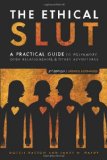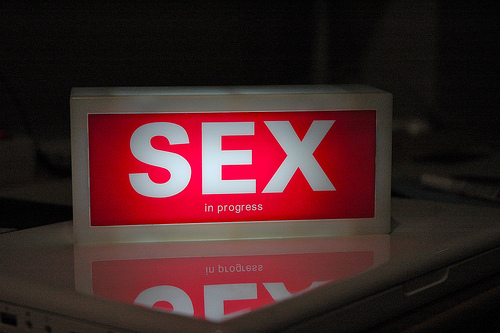I am leading a read-through of The Ethical Slut, 2nd edition. If you’d like to catch up on past installments, check the list at the bottom of the series introduction. Comments on the topics in this discussion are welcome anytime, even from people who aren’t following along in the book.
This week, the read-along continues with a discussion based on Chapter 21, “Sex and Pleasure.”
We stigmatize sex in our society. Polyamorists love to downplay how important sex is to their subculture, which might be termed an alternative sexual lifestyle. Yet very few people would seek open relationships without a desire for intimacy with more people than monogamy provides. It’s true that we cultivate all kinds of intimacies other than the obvious physical ones, but sometimes like in this chapter, it really is all about sex.

To start this chapter of The Ethical Slut, Second Edition, Easton and Hardy have to define sex itself. For many people, sex is easy to define — sex is when a penis penetrates another orifice. But actually this kind of definition is deeply limiting. When we think of sex as only a single act, we lose sight of all the other genuinely satisfying forms of pleasure we can receive. We become hung up with numbers and acts — how many people have you done what with? — and forget about the infinite varieties of stimulation which exist. Our weird attitudes about sex and what it is “good” for or how people are “supposed” to do it give rise to all kinds of damaging double standards, from slut-shaming to bisexual women who reject men with queer experience (I’ve seen dozens of these on OKCupid).
This double standard exists even among the polyamorous — tomorrow on this blog, Kiki Christie is sharing a guest post on the topic of whether polys can act “too” sexy and whether the family friendly and sex-positive poly crowds can get along. We all want sex, but some of us like to downplay it — a sign, I think, of deeply buried and continuing shame. After all if the larger culture perceives us as sluts, they won’t accept us or give us equal rights, right? This same impulse to appear normal has led “mainstream” gays and lesbians to distance themselves from queer activists and transgender people. When we define the kind of sex that is normal so rigidly, we end up ashamed of our actions and desires and trying to hide them, even when they motivate us on so many levels.
Like so much it boils down to communication — with self and others. As the authors outline, without self-knowledge (and yes, you may snicker here, I do mean that) we cannot hope to be good lovers of others. Without communicating with our partners, we cannot hope to have truly satisfying sex lives. Experienced kinksters know this — almost all of us have met an inexperienced person who claims to have “no limits,” which really means that this person has not taken the time to look at their own desires beyond a vaguely understood yearning. Though less-kinky people can sometimes get by on assumptions, they still discover that clear, open expression leads to happier, more fulfilling sex.

Overall this chapter excels at unpacking assumptions about sexuality and urging people to find clear information instead of the disinformation that abounds. Because we stigmatize sex, anything out of the ordinary gets treated worse, from fetishes to female ejaculation. There are many women out there still ashamed by what their body does, or who believe erroneously that what they are doing is peeing. The same could be true of almost any difference from normal missionary position sex — let us not forget that babies are still mutilated in the name of normal, even though normal just doesn’t exist.
Interestingly, in this chapter on dealing more sensitively with sexuality the authors have received some flack for their own sensitivity in use of language. Although there is a well written section on sex and disability, in a later part of this chapter the authors liken our inability to talk openly about sexual topics to being disabled. The writer Chally from the blog Zero At the Bone addressed this in her blog post “Disability is not your analogy,” where you can see a somewhat heated exchange between Chally and Janet Hardy. As someone with an invisible disability, I do tend to side with Chally on this issue.
On the other hand, I completely agree with Hardy and Easton that everyone needs talk about sex. One of the reasons I started writing about sex and sex toys here on this blog is because I wanted to bring my sexuality out into the open — I wanted the world to see what a polyamorist looks like, what a kinkster looks like, and begin a dialog among my friends and readers about what we might otherwise keep private. While I respect everyone’s right to privacy — and the very real need for it that many people have, from teachers to politicians — since I can live my life more openly I think it is important that I should. For every person like me, out there in the world talking frankly about sexuality, there are dozens unable to do so or too afraid to start talking about sex in their lives. I hope this series, and my words in general, inspire you to seek more openness where you can, to embrace your desires. Most of all, please don’t settle for bad sex — because we stigmatize it, we also like to pretend that we can do without satisfaction. We aren’t living in the days of hysteria anymore, but far too many people still accept unsatisfying acts as their lot in life.
So tell me — how have your sexual explorations changed you? In what ways are you more open — with your lovers, with your friends, even with the world — than you once were, or than what society tells you that you should be? Have you struggled with feeling abnormal, and how have you worked to change that?
In our next installment we’ll look at the final chapter of The Ethical Slut, Chapter 22, “Public Sex, Group Sex, and Orgies.”
